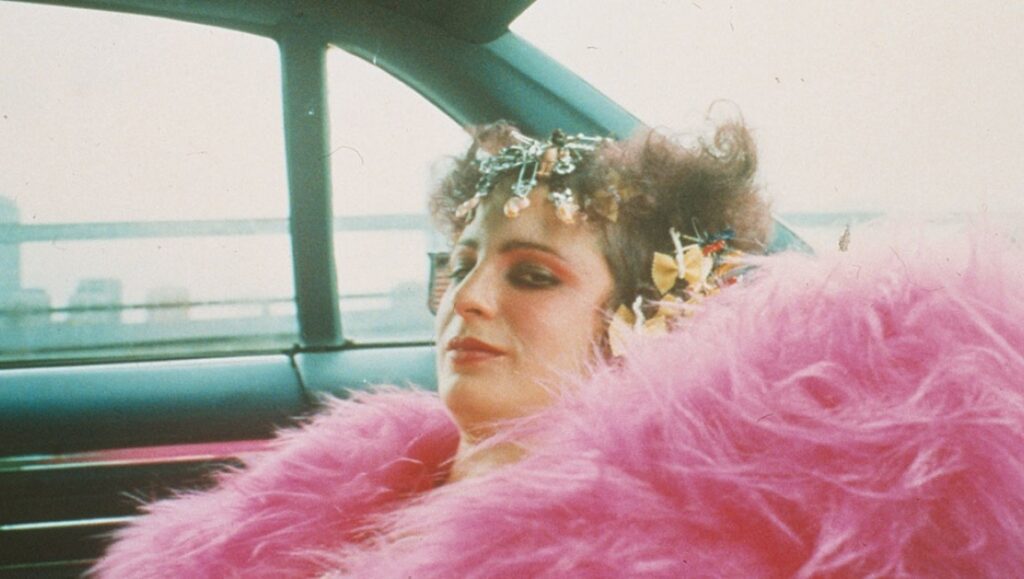All the Beauty and the Bloodshed is a film as bifurcated as its title suggests: Documentarian Laura Poitras attempts to intercut a broad-ranging, linear biography of artist Nan Goldin, told largely through Goldin’s own still photographs with narration, with scenes of Goldin’s activist work in 2018 with an organization she founded called P.A.I.N. (Prescription Addiction Intervention Now) which targeted Purdue Pharma and the Sackler family to hold them responsible for the opioid crisis. There’s a third, smaller part to this film’s structure, and it has to do with Goldin’s memories of her elder sister, Barbara, who was institutionalized at a young age and eventually committed suicide. Reviewing a trove of materials — journals, medical documents, and other personal effects — Goldin comes to the realization that medical malpractice and social stigmatism played enormous roles in her sister’s death, as did the abuse of authority figures that she herself once trusted. Poitras, then, aims to use the quite large scope of her documentary to thread this needle: To show how Goldin’s life has been defined by an interconnected series of public and private crises, and how at seemingly every turn our institutions have failed and Goldin’s trauma (expressed through her art) has accumulated.
This is a very ambitious film. Unfortunately, only portions of All the Beauty and the Bloodshed play to Poitras’s particular strengths. As Poitras proved with her two absorbing portraits of Edward Snowden (Citizenfour) and Julian Assange (Risk), she has a knack for turning complex legal and political minutiae into taut, procedural-oriented cinema. And so the passages of All the Beauty and the Bloodshed focused on the various protests staged by P.A.I.N., and specifically the surveillance that Goldin and her associates find themselves subjected to as a result, are right in this filmmaker’s wheelhouse. However, even those sequences suffer from having to share space with the other half of this film — the cross-cutting structure kills the momentum and pacing of the present-day struggle. The larger issue with the retrospective narrative that Poitras weaves through this film, though, amounts to something of a conceptual failure. Goldin’s narration — which covers some fifty years of bohemian living in Boston, Provincetown, and Manhattan — is paired with a slide-show aesthetic that explicitly nods to Goldin’s own medium. Some passages of this film are actually direct excerpts from Goldin’s exhibited slide-show works, notably 1986’s The Ballad of Sexual Dependency. But other parts merely mimic that aesthetic with Poitras’s own assemblage of photographs, and also with one crucial difference: the narration. Goldin’s slide shows were often projected with soundtracks, but the specific histories of the photos, at least, were not explicated. The photos here are deprived of that crucial interpretive element, and instead presented in a context that tends to betray their power.
By the final section of All the Beauty and the Bloodshed, the connection between the two halves of the film, and why encompassing so much history is important to its goals, becomes clearer, and it’s further elucidated by one painful observation from Goldin: “the wrong things are kept private in society, and it destroys people.” But there’s an unexplored tension in that quote and how it directly relates to Goldin’s crusade against the Sacklers, since a large part of P.A.I.N.’s platform (and a goal they ultimately accomplish) is to have the Sacklers’ names removed from the art museums that their pharmaceutical empire helped fund. Near the end of All the Beauty and the Bloodshed, and in fact just after the scene featuring the aforementioned quote, Goldin admires a plaque at the Metropolitan Museum of Art whose dedication has been changed from “the Sackler family” to “private donors,” celebrating the former’s erasure. And however one feels about the move in different spaces of society right now to remove the name and likeness of justifiably reviled people, if you open this theoretical door, by putting these two scenes so close to each other, you should walk through it; that Poitras doesn’t speaks to just how thinly spread her attentions are in a film that’s trying to cover far too many things
Published as part of TIFF 2022 — Dispatch 6.


Comments are closed.